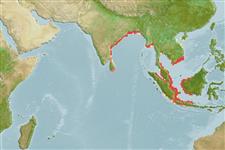>
Clupeiformes (Herrings) >
Engraulidae (Anchovies) > Engraulinae
Etymology: Stolephorus: Greek, stole, -es = garment + Greek, pherein = to carry (Ref. 45335).
Environment: milieu / climate zone / depth range / distribution range
Écologie
marin; saumâtre; amphidrome (Ref. 51243); profondeur 0 - 50 m (Ref. 189). Tropical; 25°N - 9°S, 80°E - 113°E (Ref. 189)
Eastern Indian Ocean: northern part of Bay of Bengal. Western Pacific: Gulf of Thailand, Java Sea to at least Kalimantan.
Taille / Poids / Âge
Maturity: Lm ? range ? - ? cm
Max length : 7.5 cm SL mâle / non sexé; (Ref. 189)
Épines dorsales (Total) : 0; Épines anales: 0; Rayons mous anaux: 18 - 19. Belly with 4 to 7 small needle-like pre-pelvic scutes; a small pre-dorsal spine and another on the pelvic scute. Maxilla tip pointed, reaching to or beyond hind border of pre-operculum, the latter concave, indented near maxilla tip. Anal fin short, with origin below about middle of dorsal fin base. A double pigment line on back behind dorsal fin.
Presumed coastal, pelagic and schooling, but evidently tolerates lowered salinities (e.g. in the Godavari estuary, India; Songkla Lake, Thailand and Barito River estuary, Indonesia) and possibly such places are its main habitat. More data needed.
Life cycle and mating behavior
Maturities | Reproduction | Spawnings | Egg(s) | Fecundities | Larves
Whitehead, P.J.P., G.J. Nelson and T. Wongratana, 1988. FAO Species Catalogue. Vol. 7. Clupeoid fishes of the world (Suborder Clupeoidei). An annotated and illustrated catalogue of the herrings, sardines, pilchards, sprats, shads, anchovies and wolf-herrings. FAO Fish. Synop. 125(7/2):305-579. Rome: FAO. (Ref. 189)
Statut dans la liste rouge de l'IUCN (Ref. 130435)
Menace pour l'homme
Harmless
Utilisations par l'homme
Pêcheries: commercial
Outils
Articles particuliers
Télécharger en XML
Sources Internet
Estimates based on models
Preferred temperature (Ref.
123201): 27.9 - 29.3, mean 28.8 °C (based on 456 cells).
Phylogenetic diversity index (Ref.
82804): PD
50 = 0.5000 [Uniqueness, from 0.5 = low to 2.0 = high].
Bayesian length-weight: a=0.00562 (0.00259 - 0.01222), b=3.18 (3.00 - 3.36), in cm total length, based on LWR estimates for this (Sub)family-body shape (Ref.
93245).
Niveau trophique (Ref.
69278): 3.3 ±0.4 se; based on size and trophs of closest relatives
Résilience (Ref.
120179): Haut, temps minimum de doublement de population inférieur à 15 mois (Preliminary K or Fecundity.).
Fishing Vulnerability (Ref.
59153): Low vulnerability (10 of 100).
